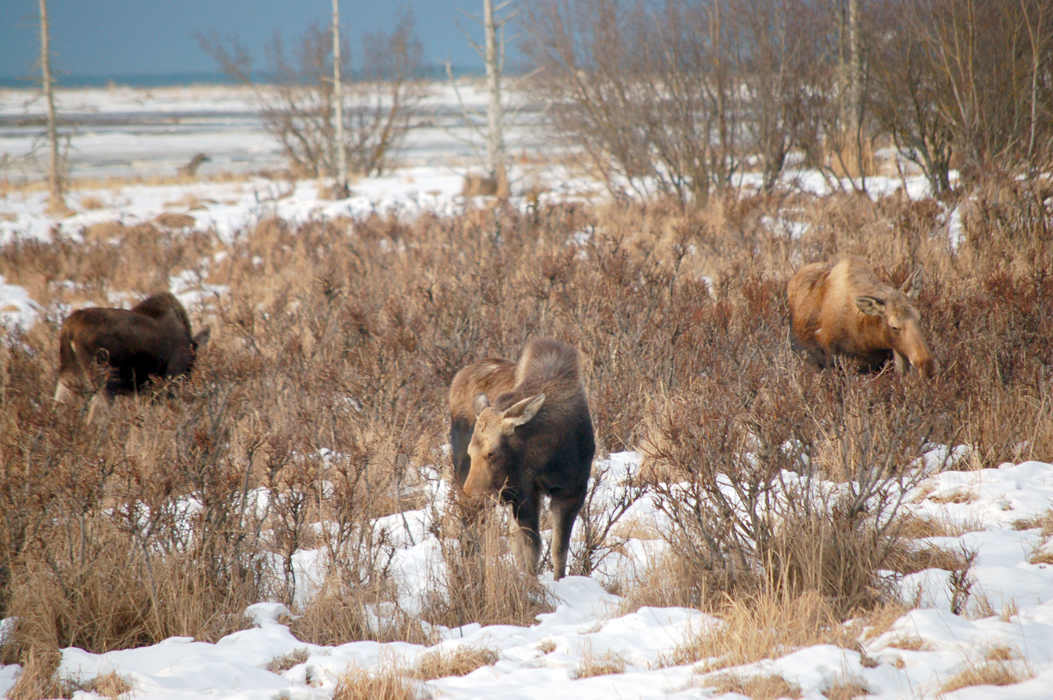In thinking about our own backyard, the wilderness and near-wilderness surrounding us isn’t just our playground. It’s the home of the almost 3,000 moose that live there.
How many moose live on the lower Kenai Peninsula? How many bulls to cows? Those are all questions people want to know about alces alces, the moose we love to look at, photograph, hunt and eat.
At the March 12 meeting of the Homer Fish and Game Advisory Committee, Alaska Department of Fish and Game biologists spoke about recent composition and census studies for moose in Game Management Unit subarea 15C, the area south of Tustumena Lake.
This winter, researchers did two moose studies. First, they did an aerial survey in November, before bull moose dropped antlers, to get an idea of the size classes of moose. Moose were classified as cows and then bulls according to antler size. That gave biologists a good estimate of the percentages of bulls with spike antlers, antlers with a spike that forks, antlers less than 50 inches wide and antlers greater than 50 inches wide. The important number is the ratio of bulls to cows. Under Fish and Game management objectives, the goal is 15 bulls to 100 cows. This year, area 15C had 22 bulls to 100 cows.
In a second survey for the census, researchers estimate the total number of moose in an area. To do that they set up grids and do an initial fly over to get an idea of moose concentrations. They count moose in low- and high-concentration areas and then come up with a proportion estimate. Biologists looked at moose in their winter range where browse wasn’t totally buried by deep snow.
As Kenai-based Fish and Game biologist Jeff Sellinger described the census area, unit 15C is basically a big hill spreading down toward Cook Inlet and Kachemak Bay, with the river and creek drainages the winter habitat.
Using those proportion results, researchers then surveyed the whole area and came up with a total estimate of moose.
“We know we don’t count every moose out there on the landscape,” said Jason Herreman, a Fish and Game moose biologist, at the Homer advisory committee meeting.
The estimate of 3,204 moose this year is up from the 2010 estimate of 2,900 moose.
“Which is a nice increase,” Herreman said. “That puts us well within our intensivemanagement goal.”
Under intensive-management guidelines adopted by the Board of Game, the moose population is managed for food and human consumption. For 15C, the intensive-management objective is 2,500-3,000 moose, with a harvest between 200 and 350 moose.
In the 2011 and 2012 hunting seasons, hunting of immature bulls — those with spikes or spikes and forks and smaller racks — was reduced to increase the bull:cow moose ratio, resulting in few bulls hunted. With better ratios, the Homer advisory committee and Fish and Game recommended to the Board of Game that the hunting of smaller bulls with single spikes be allowed again.
They also recommended changing the hunting season from Aug. 20-Sept. 20 to Sept. 1 to Sept. 20. That would allow time for antlers on bull moose to more fully develop and thus be easier for hunters to identify. At its recent meeting, the Board of Game agreed to allow the spike-fork bull hunt, but didn’t change the season.
Sellinger said the composition counts were better than Fish and Game biologists projected after the 2011 restrictions on spike and spike-fork hunting.
“We increased a little steeper than we projected with the model,” he said.
The situation for area 15A, the upper peninsula, which includes the Kenai National Wildlife Refuge, isn’t as good. Biologists counted 1,600 moose, down from 2008 estimates of from 1,825 to 2,352 moose. The problem in that area is too much of the same kind of browse, mostly mature alder trees too high for the moose to reach.
“It’s pretty obvious why we’re sitting where we are,” Herreman said. “We’ve got monotypic stands of old trees. That’s something we need to work on in 15A.”
What would help is a big fire. As biologists said — joking — they’re still advertising for fires. The challenge is that fires of the magnitude needed also would threaten development that has grown since huge fires in 1947 and 1969.
Researchers said the recent census and other studies were the best that have been done on the Kenai Peninsula.
“They’re as good as we can get,” Sellinger said.
“We were pretty happy with how effective the survey was,” Herreman added.
Michael Armstrong can be reached at michael.armstrong@homernews.com.
2012-2013 Moose surveys
Game Management Unit Area 15 C
Lower Kenai Peninsula south of Tustumena Lake November 2012 composition study Survey moose to get percentages of moose by sex, size
Calves: 14 percent
Spike-fork bulls: 16 percent
Greater than spike-fork bull: 23 percent
Less than 50-inch antlers: 54 percent
Greater than 50-inch antlers: 7 percent
Bull-cow ratio: 22 bulls:100 cows
2010 Bull-cow ratio: 9 bulls:100 cows
Management objective: 15 bulls:100 cows
February 2013 population census
Survey moose to get population estimates
2013 census: 3,204 moose
2010 census: 2,900 moose
Moose per square mile: 2.9
Moose per square mile, winter range (below 1,200 feet): about 3.9 to 4 moose per square mile
Hunter killed moose,
2010: 220
2011: 25
2012: 25
Number of hunters
2010: 1,206
2011: 405
2012: 305
Road kill moose, 15C
2009-10 winter: 51
2010-11 winter: 46
2011-12 winter: 53
2012-13 winter: N/A incomplete data


